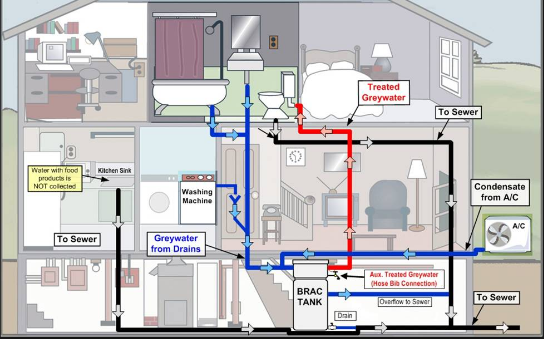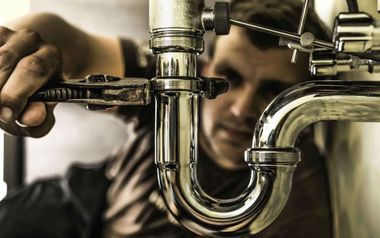What You Need to Know About Your House's Plumbing System Anatomy
What You Need to Know About Your House's Plumbing System Anatomy
Blog Article
Right here underneath you'll find additional very good insight concerning Anatomy of a House: Understanding the Components.

Understanding exactly how your home's pipes system functions is necessary for every single homeowner. From delivering clean water for drinking, cooking, and showering to safely eliminating wastewater, a well-kept pipes system is critical for your family members's wellness and convenience. In this detailed overview, we'll discover the detailed network that makes up your home's pipes and deal pointers on upkeep, upgrades, and taking care of usual problems.
Intro
Your home's pipes system is greater than just a network of pipes; it's a complex system that ensures you have access to tidy water and reliable wastewater elimination. Recognizing its parts and how they collaborate can assist you stop expensive repair services and guarantee everything runs smoothly.
Fundamental Parts of a Pipes System
Pipes and Tubing
At the heart of your plumbing system are the pipelines and tubes that bring water throughout your home. These can be constructed from numerous materials such as copper, PVC, or PEX, each with its advantages in terms of resilience and cost-effectiveness.
Fixtures: Sinks, Toilets, Showers, etc.
Fixtures like sinks, bathrooms, showers, and tubs are where water is utilized in your house. Comprehending how these fixtures connect to the plumbing system aids in diagnosing problems and preparing upgrades.
Shutoffs and Shut-off Factors
Valves control the flow of water in your plumbing system. Shut-off valves are important throughout emergency situations or when you require to make repairs, permitting you to isolate parts of the system without disrupting water circulation to the entire house.
Supply Of Water System
Main Water Line
The main water line connects your home to the community water supply or a private well. It's where water enters your home and is distributed to numerous components.
Water Meter and Stress Regulator
The water meter measures your water usage, while a stress regulatory authority makes certain that water moves at a secure stress throughout your home's pipes system, protecting against damages to pipes and fixtures.
Cold Water vs. Hot Water Lines
Comprehending the distinction in between cold water lines, which provide water directly from the main, and hot water lines, which bring heated water from the water heater, assists in repairing and preparing for upgrades.
Drain System
Drain Piping and Traps
Drain pipes lug wastewater far from sinks, showers, and bathrooms to the sewer or sewage-disposal tank. Traps protect against sewage system gases from entering your home and additionally catch debris that could create blockages.
Air flow Pipelines
Ventilation pipelines allow air into the water drainage system, avoiding suction that might slow water drainage and cause catches to vacant. Proper ventilation is important for maintaining the honesty of your plumbing system.
Value of Correct Drainage
Making certain proper water drainage stops backups and water damages. Frequently cleansing drains pipes and preserving traps can protect against pricey repair work and expand the life of your pipes system.
Water Heating Unit
Types of Hot Water Heater
Hot water heater can be tankless or typical tank-style. Tankless heating units warm water as needed, while tanks save heated water for immediate usage.
Updating Your Plumbing System
Reasons for Updating
Updating to water-efficient components or replacing old pipes can improve water top quality, reduce water expenses, and raise the value of your home.
Modern Plumbing Technologies and Their Advantages
Discover innovations like wise leakage detectors, water-saving toilets, and energy-efficient water heaters that can conserve money and decrease environmental effect.
Expense Considerations and ROI
Calculate the in advance prices versus lasting savings when thinking about plumbing upgrades. Lots of upgrades spend for themselves via reduced utility bills and fewer fixings.
Just How Water Heaters Link to the Plumbing System
Understanding just how water heaters link to both the cold water supply and hot water distribution lines assists in detecting issues like insufficient hot water or leaks.
Maintenance Tips for Water Heaters
Frequently flushing your water heater to remove sediment, checking the temperature level setups, and checking for leakages can expand its lifespan and boost energy efficiency.
Common Pipes Issues
Leaks and Their Causes
Leaks can take place as a result of aging pipes, loosened installations, or high water stress. Attending to leakages promptly stops water damages and mold and mildew development.
Blockages and Blockages
Clogs in drains pipes and commodes are often caused by flushing non-flushable products or an accumulation of oil and hair. Making use of drainpipe displays and bearing in mind what decreases your drains can protect against clogs.
Indicators of Plumbing Problems to Expect
Low water stress, slow drains pipes, foul odors, or uncommonly high water bills are indicators of prospective pipes troubles that ought to be dealt with promptly.
Plumbing Maintenance Tips
Normal Assessments and Checks
Arrange annual pipes examinations to catch concerns early. Try to find indications of leaks, corrosion, or mineral accumulation in faucets and showerheads.
Do It Yourself Upkeep Tasks
Basic tasks like cleansing tap aerators, looking for bathroom leaks making use of dye tablets, or insulating revealed pipes in cold environments can stop significant plumbing issues.
When to Call a Professional Plumbing
Know when a pipes problem calls for expert competence. Attempting complex repairs without proper understanding can result in more damages and higher repair prices.
Tips for Decreasing Water Use
Basic practices like fixing leakages without delay, taking shorter showers, and running full lots of washing and meals can conserve water and lower your utility costs.
Eco-Friendly Pipes Options
Think about lasting pipes materials like bamboo for floor covering, which is durable and green, or recycled glass for counter tops.
Emergency Readiness
Steps to Take During a Pipes Emergency situation
Know where your shut-off valves lie and just how to shut off the water in case of a burst pipe or significant leak.
Value of Having Emergency Calls Useful
Maintain get in touch with information for regional plumbers or emergency situation services conveniently available for fast reaction throughout a plumbing situation.
Environmental Influence and Conservation
Water-Saving Fixtures and Home Appliances
Mounting low-flow faucets, showerheads, and commodes can dramatically reduce water usage without giving up performance.
DIY Emergency Situation Fixes (When Applicable).
Short-term solutions like making use of duct tape to patch a dripping pipeline or positioning a pail under a leaking tap can decrease damages until an expert plumbing professional arrives.
Final thought.
Understanding the anatomy of your home's pipes system empowers you to preserve it properly, saving money and time on repairs. By complying with regular maintenance regimens and staying informed concerning modern plumbing modern technologies, you can guarantee your plumbing system operates effectively for several years ahead.
The Anatomy of Your Home s Plumbing System
Understanding the anatomy of your home s plumbing system is essential for any homeowner. It not only helps in identifying potential issues but also facilitates effective communication with professionals when repairs or upgrades are needed. Your home s plumbing system is more than just pipes and faucets; it s a complex network that ensures the efficient and hygienic flow of water in and out of your house. In this blog, we ll dissect the crucial components of your home s plumbing system. For those in Antelope Valley, Brock Plumbing is your trusted partner for all your plumbing needs, ensuring your system functions smoothly and efficiently.
Water Supply System
Main Water Line: This is where your home s plumbing system begins. The main water line connects your home to the public water supply or a private well. Pipes and Shut-off Valves: Pipes distribute water throughout your home. Shut-off valves are crucial for controlling the flow of water and making repairs without shutting off the entire system. Drainage System
Drain Pipes: These pipes carry waste and water away from sinks, toilets, and showers. Vents: Vents allow sewer gases to escape and help maintain proper pressure in the drainage pipes, ensuring efficient flow of wastewater. Traps: Every fixture has a trap, a U-shaped pipe that holds water and prevents sewer gases from entering your home. The most common is the P-trap under sinks. Fixtures and Appliances
Fixtures and appliances are the most interacted with parts of your plumbing system. They include sinks, toilets, showers, dishwashers, and washing machines. Each fixture and appliance has its own supply and drainage connection, ensuring they receive clean water and can dispose of wastewater effectively.
Water Heating System
Your water heater is a crucial component, providing hot water to various fixtures and appliances in your home. It can be tank-based or tankless, with each type having its own set of advantages and maintenance requirements. Regular maintenance is essential to ensure efficient operation and extend the lifespan of the unit.
Sump Pump
In areas prone to flooding or with high water tables, a sump pump is an essential part of the plumbing system. It s installed in the lowest part of your basement or crawlspace and pumps out water that accumulates, preventing flooding and protecting your home from water damage.
Septic System
Homes that are not connected to a municipal sewer system have a septic system and an underground wastewater treatment structure. Understanding how to maintain your septic system is crucial to prevent backups, odors, and early system failure.
Conclusion
Your home s plumbing system is a complex and essential network, ensuring the efficient and hygienic flow of water in and out of your property. Understanding its key components helps in maintaining it properly and identifying issues before they escalate into major problems. For residents in Antelope Valley, Brock Plumbing is dedicated to providing top-notch services, ensuring that every part of your plumbing system is in perfect working order. Trust our team of professionals to handle all your plumbing needs, ensuring your home remains comfortable, safe, and well-maintained.
https://brockplumbinganddrains.com/blog/the-anatomy-of-your-homes-plumbing-system/

We hope you enjoyed our article on Plumbing Installation 101: All You Need to Know. Thanks a ton for taking the time to read our piece. Enjoyed reading our review? Please quickly share it. Help other people find it. We thank you for your readership.
Visit Our Site Report this page